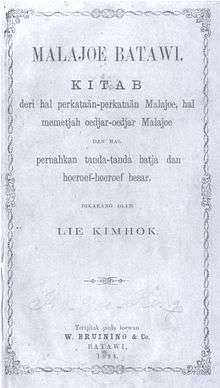Malajoe Batawi
 First printing, 1884 | |
| Author | Lie Kim Hok |
|---|---|
| Country | Dutch East Indies |
| Language | Low Malay |
| Genre | Grammar |
Publication date | 1884 |
| Pages | 116 |
| OCLC | 27142003 |
Malajoe Batawi: Kitab deri hal Perkataan-Perkataan Malajoe, Hal Memetjah Oedjar-Oedjar Malajoe dan Hal Pernahkan Tanda-Tanda Batja dan Hoeroef-Hoeroef Besar[lower-alpha 1] (better known by the short title Malajoe Batawi; Perfected Spelling: Melayu Betawi; literally Betawi Malay) is a grammar of the Malay language as spoken in Batavia (now Jakarta) written by Lie Kim Hok. The 116-page book, first published in 1884, saw two printings and has been described as the "most remarkable achievement of Chinese Malay writing".[1]
Background and writing
During the late 1800s numerous books and newspapers had been published in Batavia (now Jakarta) using a creole form of Malay. These books, including translations of Chinese works, did not use a standardised language. Some were written entirely in one sentence, with a single capital letter at the beginning and a single full stop at the end.[2]
Lie Kim Hok (1853–1912) was a journalist and teacher who wrote extensively in the creole. He considered the lack of standardisation appalling, and began to write a grammar of the language to ensure a degree of regularity in its use.[2] The same year he published Malajoe Batawi, he released Kitab Edja (Spelling Book), a book to teach spelling to schoolchildren.[3]
Contents
Malajoe Batawi's 116 pages consist of 23 pages discussing the use of capital letters and punctuation, 23 pages discussing word classes, and the remainder regarding sentence structure and writing.[4] Lie discusses various morphemes, including the active-transitive morpheme [me(N)-] and the active-intransitive [ber-].[5]
Lie identifies ten word classes in Malajoe Batawi, as follows:[5]
- "Nama paäda" (nouns)
- "Pengganti nama" (pronouns)
- "Penerang" (adjectives)
- "Pemoela" (articles)
- "Nama bilangan" (cardinals)
- "Nama kerdja" (verbs)
- "Penerangan" (adverbs)
- "Pengoendjok" (prepositions)
- "Pengoeboeng" (conjunction)
- "Oetjap seroe" (interjections)
Release and reception
Malajoe Batawi was published in 1884 by W. Bruining & Co. in Batavia. Tio Ie Soei, in his biography of Lie, describes it as first grammar of Batavian Malay,[4] while linguist Waruno Mahdi calls it the first "elaborate grammar of a Malay dialect along modern lines".[1] The book saw an initial print run of 500 copies.[4] According to Tio, it came under consideration for use as teaching material in local schools. However, the publisher requested changes with which Lie disagreed, and ultimately the deal fell through.[2] A second edition was published by Albrecht & Rusche in 1891,[6] and towards his death in 1912 Lie began writing a new edition of Malajoe Batawi. However, he died before it could be completed.[4]
In 1979, C.D. Grijns opined that, based on the primarily oral nature of Betawi, Lie did not base his Malajoe Batawi on spoken language, but the written language used by ethnic Chinese merchants.[7] Malaysian press historian Ahmat B. Adam describes Lie as leaving "an indelible mark on the development of modern Indonesian language",[8] while Mahdi writes that the grammar was the "most remarkable achievement of Chinese Malay writing" from a linguist's point of view.[1]
Notes
- ↑ Literally "Batavian Malay: Book on Malay Speech, Words, and the Use of Punctuation and Capital Letters"
Footnotes
References
- Coppel, Charles (2013). "Diaspora and Hybridity: Peranakan Chinese Culture in Indonesia". In Tan, Chee-Beng. Routledge Handbook of the Chinese Diaspora. New York: Routledge. ISBN 978-0-415-60056-9.
- Grijns, C.D. (1979). "A la recherche du "Melayu Betawi" ou parler malais de Batavia" [Researching "Betawi Malay", or Spoken Malay in Batavia]. Archipel (in French). 17 (17): 135–156. doi:10.3406/arch.1979.1464.
- Mahdi, Waruno (2006). "The Beginnings and Reorganization of the Commissie voor de Volkslectuur (1908-1920)". In Schulze, Fritz; Warnk, Holger. Insular Southeast Asia: Linguistic and Cultural Studies in Honour of Bernd Nothofer. Wiesbaden: Harrassowitz. ISBN 978-3-447-05477-5.
- "Melajoe Betawi : kitab deri hal perkataän-perkataän Malajoe, hal memetjah oedjar-oedjar Malajoe dan hal pernahkan tanda-tanda batja dan hoeroef-hoeroef besar". WorldCat. Archived from the original on 17 March 2013. Retrieved 17 March 2013.
- Tio, Ie Soei (1958). Lie Kimhok 1853–1912 (in Indonesian). Bandung: Good Luck. OCLC 1069407.
